When you invest into the stock market, you’re taught to think long term, let the money work hard, and reap the benefits in the future.
Unless you’re a skilled trader who knows how to play the long and short of it, this is your best bet if you want to grow your nest egg.
Building a physique is exactly the same.
Unless you’re blessed with the genetics of a Mr Olympia bodybuilder, and/or you’re using performance enhancing drugs, you need to think of building your physique in the same way as investing.
You need to think long term. Sure, you can drastically change your physique in 12 weeks. We do it all the time. But I’m now talking about a true transformation.
Not just where you lose a ton of body fat and build a little muscle in the process. That’s the easy bit. I’m talking about putting the work in over time to really build a physique so that when you are lean, you have enough muscle to hold your own.
That’s exactly what some of our long term members have achieved.
Look at Graham, who’s gone through three different cycles with us, and each time has finished up with a lot more muscle and a better physique than the last.
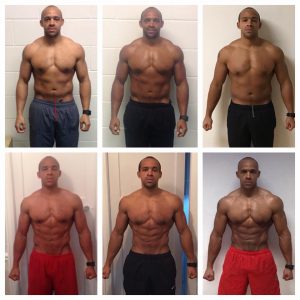
And look at Tom, who’s gone through the Five Phases of the RNT Transformation Journey over the past few years. After finishing up his most recent Process Phase, he sent me an email saying: “People might look at that transformation and see 12 weeks’ worth of effort to get in shape. But for me – that’s 3 and a half years of effort, discipline and dedication. And that’s only possible because of RNT.’”

I love receiving unexpected emails like this. It makes what we do so fulfilling and reminds us why we do what we do. It also triggered a conversation with Tom who began to talk about the need for people to understand what truly goes into building a physique if you live a normal, busy life with average genetics,
I thought this was a great idea, and it starts with explaining the concept of the RNT Transformation Journey.
When you start your quest to transform your physique, the first port of call in almost all cases (unless you’re skinny ripped), will be to get lean.
This can take anywhere from 8 weeks to 18 months, depending on how much you have to lose, and this will be your focus in the CTP and Process Phases.
Let’s take the average person who can get really lean in 12 to 24 weeks. In most cases, what tends to happen is you’ll get lean, and then either put it back on, or just cycle between gaining a little and cutting it back off for eternity. You never really make any progress beyond the initial ‘getting lean’ phase, and end up looking the same forever.
Now, this might be fine if you’ve come from a very high body fat range, and you just want to maintain your condition now. But for the most part, what you’ll realise is once you’ve got lean, you’ll want some more muscle to help fill your frame and T-shirts.
You want certain body parts to develop and grow, and you want to take what you’ve achieved to the next level.
This is when the real work begins. Tom was never afraid of this. He was lean, but he wasn’t satisfied with his physique. He wanted a body like David Gandy (sorry Tom, but your constant reminders in your emails means I can’t not include this!). This wasn’t going to happen staying lean. He needed to spend time building muscle!
Speaking of Gandy, I asked Tom where this all came from, to which he responded:
“I think it’s representative of having the goal in mind at all times. I didn’t think I’d achieve it to be honest, but it was good to constantly have a ‘true north’ and understand where you are next to it. I chose Gandy because he wasn’t shredded to the point of vascularity, and still looked great in a suit – both things I thought more closely aligned with my goal of sustainability.

On reflection, I also asked Tom what his mindset was behind accepting a little body fat and spending time building muscle.
“I thought of muscle building as an investment. I knew that if I was able to pack on muscle now then it would a) assist with fat loss later and b) mean that my maintenance calories would probably be slightly higher than otherwise (i.e. “building a bigger engine”). That meant that ultimately, when calories came back up, I’d have a better chance of sustaining a good physique whilst enjoying food and life! Not sure if the science stacks up, but that’s what I was aiming at!”
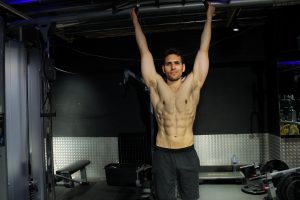
If everyone could have this investment mindset behind building muscle, we’d see a lot more impressive physiques around!
In my own case, I knew after my 2014 I had to make serious improvements to my legs and arms if I wanted to be competitive in the open men’s class of bodybuilding.
So I spent 2.5 years making steady investments. Calories, weight on the bar, reps, more calories, more weight, more reps. And repeat. I wanted to reap the rewards of my continuous investment.
The investment paid off, and I cashed in during my 2017 prep with shredded glutes, feathered triceps and a physique I never thought I could have.
Let’s dive a little deeper in Tom’s transformation now…
Building a Larger Engine
If you want to build muscle, you need to start lean. Starting a proper Investment Phase while still carrying body fat is only going to make you very good at getting fatter and fatter. Your body just won’t be sensitive to nutrient uptake, and your hormonal profile will be out of whack.
Think one step back, two steps forward here.
In Tom’s case, he needed a good 10-14 weeks to ‘prime’ his physique for the upcoming building phase.
So we started with a second Cleaning the Palate and going through a stringent Process Phase.

What he really struggled with in these phases was variety. After auditing his nutrition on his commute to work, he realised he was only eating 6-7 different ingredients in a week.
For many people, keeping boring and ‘same’ can work great, as it reduces a lot of the stress associated with introducing too much variety. For Tom though, sustainability and enjoyment of food was important for him. So we began to introduce a little more variety, and, critically to his goal, Tom was starting to educate himself on the different aspects of nutrition.
This is something we really try to go through with our members. In the early stages, it’s always best to follow a set plan and focus on ‘learning the lifestyle’. But for true sustainability, it’s essential to begin the process of self-education so that you can introduce variety and ‘flex your macros’ to fit around social occasions.
With a hectic travelling schedule, this education meant Tom was able to seamlessly implement correct eating habits no matter where he was, while still making progress towards his goals.
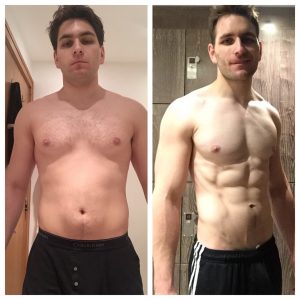
The Consolidation Phase
Every time Tom had dieted in the past, he’d always put it all back on very quickly. He’d never found anything that he was able to sustain and build into his lifestyle. He didn’t want to make this mistake anymore, so was committed to a diligent and structured Consolidation Phase.
Once you’re in shape, a successful reverse out of a calorie deficit can really help set yourself up for future success. Spending 4-6 weeks steadily increasing calories and reducing cardio/activity means you can enter a small calorie surplus while still in good condition. Tom did exactly this, and he was now well and truly primed for the most important stage.

The Investment Phase
It was time for Tom to build and invest heavily into his physique.
This when it’s all about PRs (Personal Record) on the bar and PRs on the plate.
This is when you can build your weak points and start to create the foundation of muscle mass that’s often lacking.
When people wonder why they can’t reach low levels of body fat, or why they don’t have a filled out and well defined [personal choice of favourite body part] when they’re lean, or why they look skinny when lean, it’s because they just don’t have enough muscle.
You need muscle to look good when lean. And this is why the more years you put into building a foundation, the better you’ll look when it comes down to dieting.
The problem is, it’s so difficult to stay on track in an Investment Phase when you’ve got no real immediate deadline. I actually think this is the hardest part of body transformation. It requires more accountability and support than fat loss.
While it won’t be as intense as when in a fat loss phase (in terms of pressure and deadlines), I see it with many people who end up lost in muscle building phases where they make no progress. And then to spark the illusion of progress, they diet again only to look exactly the same as last time.
Tom treated this phase seriously. He knew this was where he was going to make all his money in the future. Food was high, and we ended up taking carbs up to around 400 grams a day, with calories closing in on the mid 3000s. This was completely new territory for Tom, but he was trusting the process and knew what we wanted to achieve.
In Tom’s own words, ‘Psychologically it was hard to see some fat gain – but legitimate performance gain, and the long term mentality really helped’.
This was after the ‘bulking phase’. While he had gained some body fat, he was looking noticeably thicker in his chest, arms and shoulders in particular.

The Reward Phase: True Transformation
When you’ve spent time building your foundation, this is when you can really achieve true transformation.
This is when the habits are firmly ingrained into your lifestyle. Training is second nature, eating well is the norm, and you’re now ready to unveil all the hard work you’ve been putting in.
After months of ‘bulking’, I remember Tom was pumped for this. He’d put in the work, and spent a long time in the ‘hazy body fat zone’ that can make tracking progress so difficult.
But he’d put the work in. He was stronger than ever and eating a ton of food. His engine was primed and it was time to cash out the profits.
I asked Tom after we finished this phase what he thought were the ‘game changers’ for him during this stage. He decided to put it together in a post for all our members to see in our private RNT Family group:
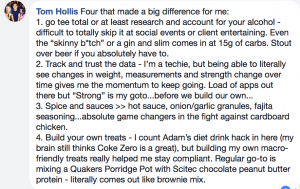
Point one can be a real difference maker if you’re not accounting for it. Alcohol does contain calories, and if you’re not accounting for it, it can take you out of a calorie deficit very quickly.
During the first 6-8 weeks of this transformation, Tom was guilty of not tracking alcohol intake, and thinking because it was a gin and slimline tonic, there was no need.
It wasn’t until calculating retrospectively he realised he was overshooting his carb intake by 15-20%. This adds up!
Drinking while dieting can be done. It just needs to be factored into your calorie intake and kept under control. The real problem with alcohol lies in its ability to skew your decision-making abilities (chicken kebab anyone?), reduce willpower and possibly affect your training performance.
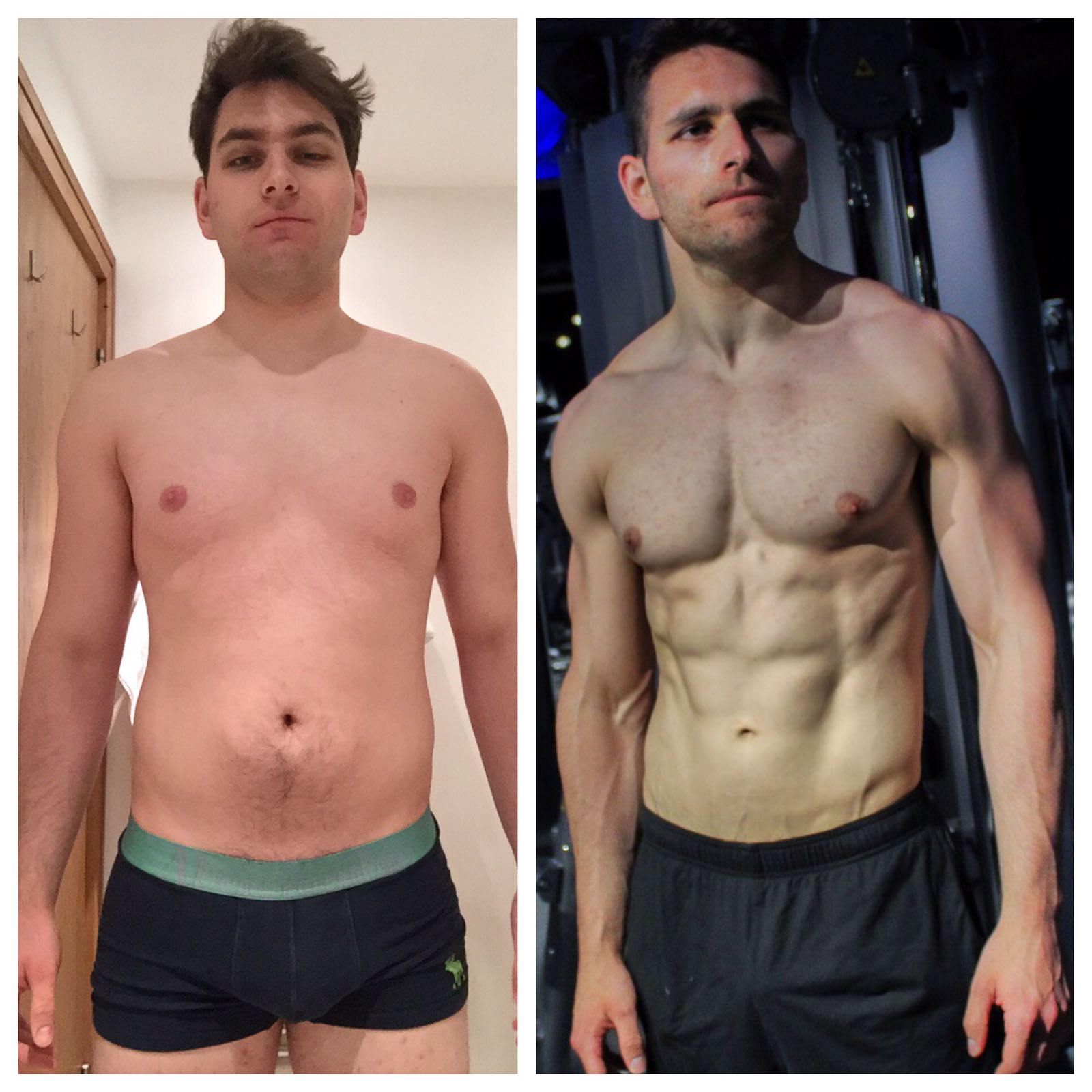
Creating The Ultimate Lifestyle Solution In Reward-Investment!
Job done! We’d reached (and beaten) David Gandy status! But Tom wasn’t done with his journey, his goal was to keep Investing and continuing to build his physique. He had seen the value in long term investment and he was keen to see how far he could build. So now it was time to execute a well considered Consolidation Phase, and re-enter Investment again.
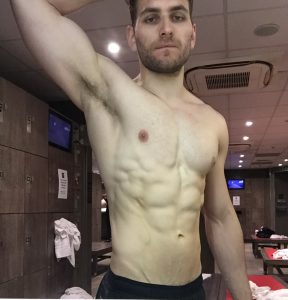
That means repeating the process of PRs on the bar and PRs on the plate, and ‘embracing the fluff’ to move up to another level in his physique.
The results?
2 years later again, Tom has done another photoshoot, and proved the benefits of continuing to invest in the Transformation Journey.
And the next plan?
Continue on the journey!
He’s built the muscle he wanted, so now isn’t concerned by aggressive bulking phases to maximise his growth opportunities. Instead, he wants to maintain good condition year round, continue to make improvements where he can, and now truly reap the rewards from the years of investing into his physique!

‘Tom the Techie’
I’m no expert when it comes to tech. So when someone like Tom comes along who’s a tech wizard, I’m always blown away by the cool ‘simple’ spreadsheets they quickly create to track various data points.
I know many of you will want to know the dietary changes we made with Tom over the course of the various stages, so I’ve extracted a screenshot of a graph Tom designed to show the relationship between his bodyweight, calorie/macro breakdowns and the changes over time.
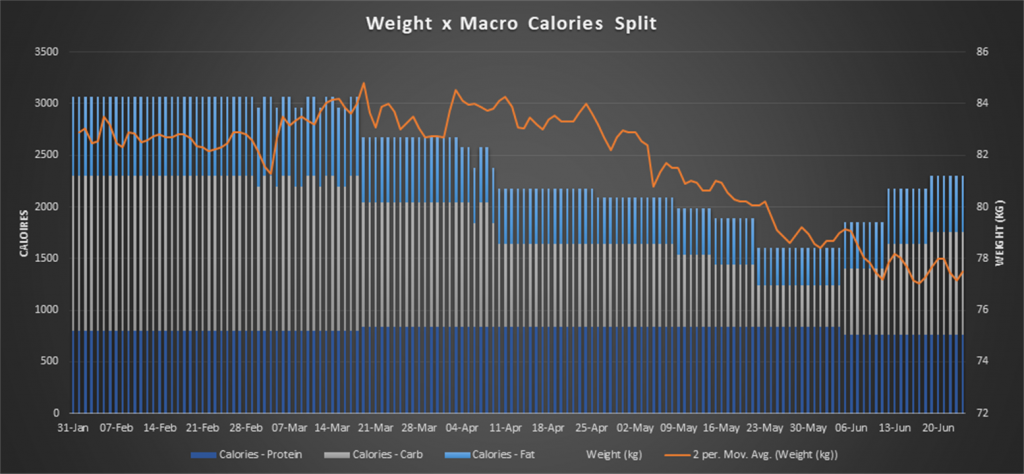
This graphic is specific to one timeframe of his journey earlier on, so you’ll notice three parts to this graph.
- January to mid March – Heavy Investing. This was the tail end of his Investment Phase where he was fluctuating between 82 and 84kg with a fairly consistent calorie intake of just over 3000 a day (not including meals off plan etc.)
- End of March to early May – Process Phase Begins. Despite dropping fats and carbs by a fair amount, body fat wasn’t reducing a whole lot considering the changes made. In hindsight, Tom believes this was due to the untracked alcohol intake.
- May – #VaghelaGrind. This coincided with the time Tom started to account for alcohol, and we began to be a little more aggressive with the diet. It’s safe to say this worked and delivered the result necessary. In these 4 weeks, Tom’s body was changing dramatically and it was cool to see the rewards of ‘gathered momentum’ coming to fruition.
- June – The Consolidation Phase. This is when we began the reverse diet, and what you’ll notice is the increases in calories having minimal impact on body weight.
Tom on RNT Fitness Radio
Due to popular demand from fellow RNTers, Tom has appeared twice on RNT Fitness Radio to discuss his journey.
Testimonial
Here’s what Tom had to say about his overall experience training with RNT:
“At first I was quite nervous moving back to online training as I’d had bad experiences in the past: cookie cutter programs, bad response times and a general lack of empathy / care from the trainer.
The results at RNT speak for themselves, but what I think was great about Akash was when things got tough. For me, anyone can train natural genetics and just keep reducing calories as everything goes according to plan. But the real test is when things don’t go to plan. My progress stalled several times, seemingly for no reason, and Akash patiently adjusted, tested and re-focused to get us back on track.
Cookie cutter programs wouldn’t be able to adjust in these situations – but RNT’s approach, based on science and client experience, really shines here. Importantly, it’s called coaching for a reason. By following RNT’s consistent online tuition, I’ve learned how to motivate and regulate myself. This has given me the tools to make smarter decisions both in the gym and the kitchen to help maintain the progress I’ve made. I’d thoroughly recommend the RNT experience to anyone.”








